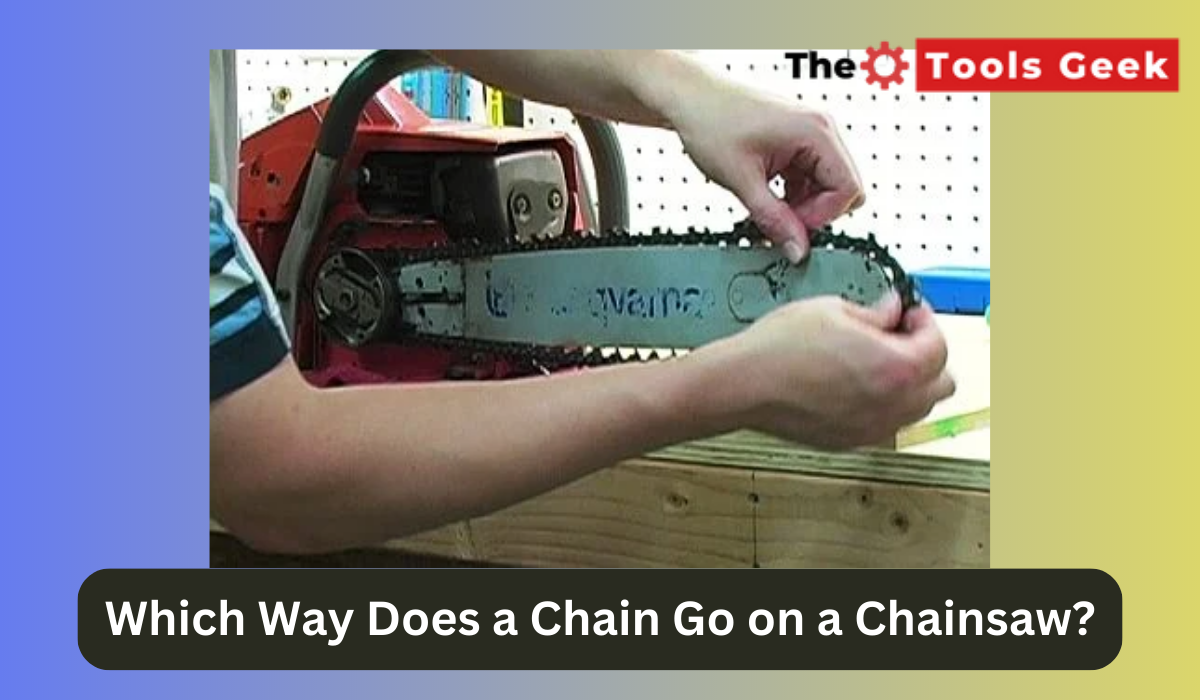Power tools are extremely easy to handle when you follow the correct method. But things can go out of hands when you use them in the wrong direction. In terms of chainsaws, this is no exception.
Chainsaw requires a significant level of care and maintenance. A single error will increase the risk of accident to the user, noticeably the chainsaw blade direction. If the chainsaw chain rotates in the wrong direction, it can poorly cut the required material. Also, it may cut something else accidentally.
Ever wondered, which way does a chain go on a chainsaw when you work? Let’s dive deeper to learn more about the chainsaw chain direction.
Understanding Chainsaw Chain Direction
The chainsaw chain must rotate in the right direction, and make sure to check it every time before you press the start button.
So, what is the right direction of a chainsaw chain?
Counterclockwise rotation of the chain will happen when the chain bar is located on the engine’s left side. Also, the cutting edge should be facing away from the engine.
In simpler words, make sure the chain is installed according to the below points.
- The drive link points forward
- The cutter faces forward
- The guide (shorter piece) goes in front
Generally, you can’t cut a wood plank with a backward rotating chainsaw saw. When a chainsaw chain is set backward, technically, you face all the cutters, which can create a dangerous situation. To avoid life-threatening risks and get efficient cutting, it is significantly essential for you to run a chainsaw in the correct direction.
Why does a Chainsaw Chain rotate in the Wrong Direction?
Well, solving a problem becomes easier when you know the root cause. Ideally, the chainsaw chain always rotates in the right direction, but it can go the wrong direction when the below pointers happen:
- Blunt chainsaw blade
- Installing the chain in the wrong way by mistake
- Improper tension of the chain
What Problems Can I Face Due to Chainsaw Chain Wrong Direction?
You will face several problems if a chainsaw chain follows the wrong direction while cutting. Some problems can be life-threatening. The complications are as follows.
Wastage of the Bar Oil
The wrong fixation of the hawser will cause a lot of waste of the bar oil. This way, more harm may happen to the saw. Usually, bar oil is preserved until a project gets completed. But if the direction is done upside, resulting in a lot of wastage.
Damage to Chain Link
Chain link plays a significant role in a chainsaw. A chainsaw will fail to operate completely when the chain link is damaged. You will find this component in the bottom of the chainsaw, supporting the blade for easy propelling. Make sure the drive link is installed correctly and in the right place.
It May Frustrate You
Operating a chainsaw efficiently is a necessary skill that users need to prove their worth. The wrong direction of the chainsaw chain can frustrate you; even it can cost your job. For example, completing a client’s project and struggling to operate the chainsaw proficiently would show a lot of unskillfulness.
Creates Excessive Pressure on the Guide Bar
Guide bar ensures well-aligned cutting. When a chain rotates backward, you will put lots of force; thus, the guide bar will receive excessive pressure. Finally, you will end up with improper alignment, meaning poor finishing. At the same time, unnecessary force may damage the guide bar.
Burnt Clutch
The improper direction of the chainsaw chain will not let you cut anything. So, after starting the saw, you will habitually keep pressing the clutch when you see the chain is not moving. In the end, the clutch will burn.
How to Make Sure the Chainsaw Chain Direction is Correct?
By now, you already understand the importance of operating a chainsaw in the right direction. For a new person, it can be pretty overwhelming to know the correct direction of the chain before using it. No worries! Here are a few tips.
Inspect from the Upper View
The chainsaw chain consists of a different blade, and they can be seen clearly from the top view. Each blade has 2 edges: sharp and dull. Remember, a chainsaw blade always rotates clockwise regardless of the model or type. This means the sharp edges will always face a clockwise direction. Before operating the chainsaw, intently look at the chain from the top. You will see that the sharp edges of the chain are facing the chainsaw motor’s or engines’ reverse direction.
Look at the Chain from Side and Front
Check the blade from its side. What are you seeing? The chainsaw engine should be on your left-hand side, and your right side, you should see the chainsaw blade. In this case, the chain direction would be from left to right. This direction is clockwise, and it is the correct track of the chainsaw chain.
Don’t forget to check the saw from its front. When a chain is installed correctly, it should rotate from upside to downside. If you see the backward movement of the chain, be sure you installed the chain incorrectly.
Inspect from the Bottom Side
The bottom view of the blade will be opposite the top view. If your chainsaw chain installation is done correctly, you will see that the sharp edges of the chain are facing towards the chainsaw motor or engine. Also, the sharp edge will constantly rotate towards the clockwise track.
How to Replace or Install Your Chainsaw Chain in the Right Direction?
While replacing or installing your dull chainsaw chain, you need to be extra careful with the correct installation. The process is so straightforward that you can do it within a few minutes. Follow the below steps carefully.
Step 01: Chainsaw Bar Attaching
Attaching the chainsaw bar is the first step of installing or replacing a dull chain. For this, removal of the bolt is required. Once the bolt is removed, place the bar at the right position and attach it by firmly fastening the bolt. The bar should have the perfect length according to the requirement of the chain fittings.
Step 02: Chainsaw Chain Direction Checking
We are at the crucial step of the installation process. When mounting the chain, pay additional attention to ensure everything is going correctly.
If the installation is done perfectly, you can operate the machine without trouble. Hopefully, you already know the checking procedure of the correct chain direction; ensure you are completing the process right.
Step 03: Blade Tightening
Fine-tuning or tightening of the chain is needed once the below factors are assured.
- Right attachment of the chain bar
- Proper mounting of the chain
- Blade direction is right
It is important not to over tighten the chain. Simultaneously, don’t make it too loose. Both can be dangerous for the user. Moreover, you will not get an efficient result.
Important Note:
- Don’t fit the chainsaw chain too tightly
- Keep the chain a little bit loose
- Check the chain placement if it is installed correctly
Frequently Asked Question
What are the signs of a dull chainsaw chain?
If you see the below signs while working with your chainsaw chain, most probably, the chain is dull.
1. You are pushing the chainsaw to make a cut
2. Generally, a chainsaw creates large wood chips. A chainsaw with a dull chain produces fine sawdust
3. When the chainsaw starts crooked cut
4. Bouncing or shaking during the cur is another sign
Is it easy to replace a chainsaw chain?
Yes, replacing a chainsaw chain is extremely easy. But be attentive when you plan to replace a dull chain. It is because correct installation is mandatory to avoid dangerous situations. Follow the replacement or installation process meticulously.
How often should you replace your chainsaw chain?
The durability of chainsaw chains varies from one to another. However, all chainsaw chains dull over time.
A good quality chainsaw chain offers the best result maximum of 5 years when used extensively. On the other hand, you will get service for a decade when used occasionally.
You need to keep in mind maintenance plays a significant role in the longevity of a chain.
Can a chain on a chainsaw “stretch”?
Technically, the chainsaw chain doesn’t stretch. But the chain can get longer after the first use of the chainsaw. The reason is metal gets expanded when the chain is heated. Another reason is the chain links or rivets wear out over time. Due to these conditions, the chain gets longer, technically not “stretched.”
Wrap Up
Hopefully, this comprehensive guide makes things clear. Now you know how a chain goes on a chainsaw and how to prevent problems related to the wrong chainsaw chain direction.
If you are replacing or installing your chainsaw chain for the first time and are not confident enough to do the job, we recommend you to take your chainsaw to a local dealer and let them handle the chain installation process.
What is more! Ensure periodic maintenance and get long-term efficient service from your chainsaw.

